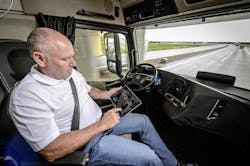Will the costs of autonomous commercial vehicle (ACV) technology in the trucking industry overshadow the benefits? Or will it prove to be the other way around, with fuel savings, driver lifestyle enhancement, and safety improvements outweighing the price tag of ACVs?
Global consulting firm Frost & Sullivan delved into those questions in a new study entitled The Strategic Outlook of Autonomous Heavy-Duty Trucks and found that some “price-sensitive” markets may be slow to adopt such technology, whereas in others – notably the long-haul trucking sector – may experience at minimum a return on investment (ROI) period of three years.
Wallace Lau, an industry analyst with the automotive & transportation practice at Frost & Sullivan told Fleet Owner that a variety of ACV-related systems are already in use today within the trucking industry, such as electronic stability control (ESC), collision avoidance technology, rear- and forward-view camera systems, plus related electronic sensor arrays needed for transmitting data between such systems and a truck’s engine, transmission, and brakes.
“In fact we’re already seeing the use of true ACVs in the agricultural, defense and mining industries today,” he explained. “The key question is how OEMs will package and sell ACVs as a benefit to [trucking] fleets.”
Frost & Sullivan’s research indicates the incremental cost of ACV right now is around $30,000 compared to a “standard” truck operated by a human driver – an incremental cost that covers new sensors, telematics upgrades, human-machine interface (HMI) connections, driveline enhancements, and software algorithms.
While Frost & Sullivan predicts early-stage ACVs will see active use on North American roadways by 2025 – largely in “truck platooning” operation – the total incremental cost for autonomous driving technology in commercial vehicles won’t decline by more than 10%, largely due to information technology (IT) needs.
That’s mainly due to cyber security and safety needs, Wallace said. “Any vulnerable electronic interface will need to be secured, especially as [ACV] systems are going to be extremely complex,” he added. “There will also need to be multiple redundancies in case primary [control] systems fail or if there’s a cyberattack on them.”
Frost & Sullivan doesn’t expect to see fully autonomous trucks deployed on U.S. roadways for at least another two decades. From a global perspective, the firm predicts an estimated 7,970 autonomous-enabled trucks will be sold worldwide by 2025 for on-road applications, rising to 182,031 units by 2035.
Sandeep Kar, global director of automotive & transportation research, told Fleet Owner that three key total cost of ownership or TCO benefits should make ACV technology an attractive investment for on-road fleets over time.
“It starts with driver satisfaction, for both existing and future truck operators,” he explained. “Drivers won’t have to physically operate the truck for long periods as the [ACV] technology will allow them to take breaks and stay connected with the world outside while in the cab. That ‘connectivity’ will be very important for recruiting younger drivers.”
Increased fuel efficiency and lower maintenance costs from more “optimized” truck operation due to ACV guidance systems, alongside improved safety performance, will round out the gains fleets should get from so-called “driverless” trucks, Kar added.
Especially in long-haul operation, he believes autonomous technology could not only help alleviate the driver shortage but also offer an alternate to wage hikes as it would provide drivers with a less-stressful and safer work environment.
“Take truck ‘platooning’ which is really the first step in the ACV process,” Kar pointed out. “Here drivers could take say two hour turns driving at the head of a platoon, then switch with another driver. It allows them to ‘disengage’ with driving for set periods and that would probably help attract more entrants to the profession. That’s why we see a possible solid ROI for this technology.”
About the Author
Sean Kilcarr
Editor in Chief
Sean Kilcarr is a former longtime FleetOwner senior editor who wrote for the publication from 2000 to 2018. He served as editor-in-chief from 2017 to 2018.
